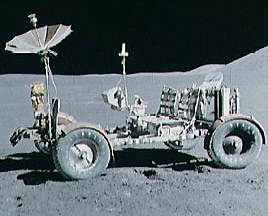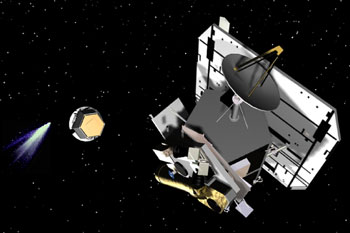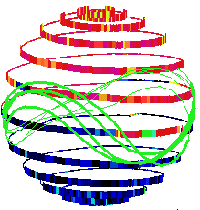This figure was made by Geza Erdos of the KFKI in Budapest. It shows the polarity of the Sun's magnetic field as Ulysses traveled from the south pole to the north pole.
Click on image for full size
Imperial College
The Sun's Magnetic Field Polarity
This image shows the magnetic field polarity that Ulysses measured while traveling from the South pole to the North pole of the Sun. Blue values represent regions where the magnetic field pointed toward the Sun, red where it pointed away. Green lines represent the boundaries between the two hemispheres.
You can better understand this if you imagine the Sun having a huge bar magnet inside of it. If the positive end of the magnet was at the north pole of the Sun, magnetic field lines would come from the north pole of the Sun (pointing away like in the picture) and would loop around to the south pole of the Sun (pointing in toward the Sun like in the picture).
Scientists are still working to better understand the magnetic field of the Sun.
You might also be interested in:

The force of magnetism causes material to point along the direction the magnetic force points. As shown in the diagram to the left, the force of magnetism is illustrated by lines, which represent the force.
...more
The Hubble Space Telescope (HST) was one of the most important exploration tools of the past two decades, and will continue to serve as a great resource well into the new millennium. The HST found numerous
...more
Driven by a recent surge in space research, the Apollo program hoped to add to the accomplishments of the Lunar Orbiter and Surveyor missions of the late 1960's. Apollo 11 was the name of the first mission
...more
Apollo 12 was launched on Nov. 14, 1969, surviving a lightning strike which temporarily shut down many systems, and arrived at the Moon three days later. Astronauts Charles Conrad and Alan Bean descended
...more
Apollo 15 marked the start of a new series of missions from the Apollo space program, each capable of exploring more lunar terrain than ever before. Launched on July 26, 1971, Apollo 15 reached the Moon
...more
NASA chose Deep Impact to be part of a special series called the Discovery Program on July 7, 1999. The Discovery program specializes in low-cost, scientific projects. In May 2001, Deep Impact was given
...more
The Galileo spacecraft was launched on October 19, 1989. Galileo had two parts: an orbiter and a descent probe that parachuted into Jupiter's atmosphere. Galileo's main mission was to explore Jupiter and
...more















